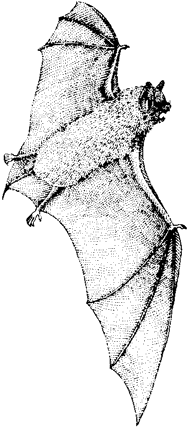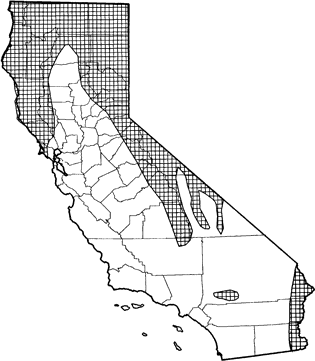
Little Brown Myotis
Distribution, Abundance, and Seasonality
Common and widespread in North America. In California, occurs from Oregon border south along coast to San Francisco Bay and probably to Monterey Co., and along the Sierra Nevada/Cascades and Great Basin from the Oregon border to Kern Co., and along Colorado River. An isolated population also exists in the San Bernardino Mts. Fairly common throughout its range and abundant in some areas. Although details of abundance not well known in California, appears to be most common in mid- to high-elevation forests. Fairly common in sagebrush, bitterbrush, alkali desert scrub, wet meadow, and montane chaparral. Least common in valley foothill woodlands, redwood, mixed chaparral, low sagebrush, alpine dwarf-shrub, coastal scrub, and grasslands.

Range Map
Specific Habitat Requirements
Feeding: Feeds on small (3-10 mm), flying insects located by echolocation. Lactating females tend to take larger prey. Preys heavily on seasonally available aquatic insects, such as chironomid midges (Fenton and Barclay 1980). Such insects tend to have a patchy distribution, particularly mating swarms. Appears adapted for exploitation of patchily distributed prey. Its flight is maneuverable, and it has the ability to detect prey at a short distance. Several prey may be captured in rapid succession using interfemoral membranes. Masticates and digests food rapidly. Feeds low over water at margins of lakes, streams and ponds, as well as along forest edges. It returns to regularly used feeding areas (Hough 1957, Buchler 1976, Belwood and Fenton 1976, Anthony and Kunz 1977, Whitaker et al. 1977, 1981, Fenton and Bell 1979).
Cover: Uses separate day, night, hibernation, and nursery roosts. Populations limited by availability of roost sites. Day roosts located in buildings, trees, under rocks or wood, or occasionally in caves. Night roosts located in similar sites, or even the same sites, but usually in more confined spaces. Temperatures usually warmer, as many bats pack into night roost. Lactating females may not use a night roost, which may be related to their use of heterothermy as an energy saving strategy. Hibernation roosts in caves or mines. Temperatures usually above freezing, and humidity is high (90% or more). Quick to locate new roosting sites, particularly during autumn dispersal. Apparently establishes scent posts (Buchler 1980), which may function in location of roost sites (McManus 1974b, Burnett and August 1981, Barclay 1982).Reproduction: Nursery roosts usually in buildings, but also in other locations with suitable temperatures. Nursery sites warm, correlated with high growth rates of young (Fenton and Barclay 1980).
Water: Requires water; has relatively poor urine-concentrating ability. Intra-specific variation in ability to produce concentrated urine (O'Farrell et al. 1971, Bassett and Wiebers 1979).
Pattern: Prefers to feed over water or open habitats.
Species Life History
Activity Patterns: Nocturnal; hibernates. Emerges at dusk. Activity peaks about 2.5 hr after dusk. There may be a second activity peak before dawn (Barbour and Davis 1969, Kunz 1973). Individuals may enter torpor daily in non-hibernating seasons. Hibernation lasts from September-November to March-May, depending on latitude and altitude. Young remain active later in fall to accumulate sufficient fat reserves. Hibernators may be inactive for 90 consecutive days (Stones and Wiebers 1967, Fenton and Barclay 1980).
Seasonal Movements / Migration: Makes local, or long-distance (several hundred km), migrations to hibernacula. Considerable fall movement, and large aggregations swarm at hibernacula at this time. Such swarming associated with mating. Individuals swarming at a site may hibernate elsewhere (Davis and Hitchcock 1965, Humphrey and Cope 1976, Thomas et al. 1979).
Home Range: No data found. Probably travels up to several km between day roosts and feeding sites.
Territory: There is no evidence of territoriality. Aggregations of up to 300,000 individuals have been reported (Cockrum 1956).
Reproduction: Mating occurs in fall. Fertilization is delayed to the following spring. Young born after a gestation of 50-60 days. Births occur May-August. In southern, or lower elevation populations, peak in births is May-June, and at higher elevations, peak may be in July. Generally 1 young born each yr. There are a few records of twins. The young are weaned and begin to fly at 3 wk. Early foraging attempts involve fly-catching of passing insects from a perch. Females breed in first yr, males in second yr. First winter is period of highest mortality. Average life span is 1-2 yr. The maximum recorded age is 31 yr (Gillette and Kimbrough 1970, O'Farrell and Studier 1973, Humphrey and Cope 1976, Thomas et al. 1979, Fenton and Barclay 1980).
Niche: Occurs at feeding and roosting sites with many other bat species. Predators include birds, snakes, small carnivorous mammals, and mice (Gillette and Kimbrough 1970). Can be rabid, but incidence usually less than 1% (Fenton and Barclay 1980).
Comments: Populations in many areas have suffered drastic declines. Contributory factors include pesticides (Geluso et al. 1976, Kunz et al. 1977, Clark et al. 1978), disturbance, and control efforts (Fenton and Barclay 1980). Fat-soluble pesticides dangerous in combination with migratory stress and depletion of fat reserves in hibernation and migration. Disturbance in winter destructive because of energy expense of arousal. M. I. occultus is a California Species of Special Concern. This species and Yuma myotis are very similar and may hybridize. Harris (1974) and Parkinson (1979) discussed taxonomy and identification.
Sources & References
California Department of Fish and Game, 1999.
California's Wildlife, Sacramento, CA.
Written by: J. Harris, reviewed by: P. Brown, edited by: J. Harris, R. Duke
Anthony, E. L. P., and T. H. Kunz. 1977. Feeding strategies of the little brown bat, Myotis lucifugus, in southern New Hampshire. Ecology 58:775-786. Barbour, R. W., and W. H. Davis. 1969. Bats of America. Univ. of Kentucky Press, Lexington. 286pp. Barclay, R. M. R. 1982. Night roosting behavior of the little brown bat, Myotis lucifugus. J. Mammal. 63:464-474. Bassett, J. E., and J. E. Wiebers. 1979. Subspecific differences in the urine concentrating ability of Myotis lucifugus. J. Mammal. 60:395-397. Belwood, J. J., and M. B. Fenton. 1976. Variation in the diet of Myotis lucifugus (Chiroptera: Vespertilionidae.) Can. J. Zool. 54:1674-1678. Buchler, E. R. 1976. Prey selection by Myotis lucifugus (Chiroptera: Vespertilionidae). Amer. Nat. 110:619-628. Buchler, E. R. 1980. Evidence for the use of a scent post by Myotis lucifugus. J. Mammal. 61:525-528. Burnett, C. D., and P. V. August. 1981. Time and energy budgets for day roosting in a maternity colony of Myotis lucifugus. J. Mammal. 62:758-766. Clark, D. R., Jr., T. H. Kunz, and T. E. Kaiser. 1978. Insecticide applied to a nursery colony of little brown bats (Myotis lucifugus): lethal concentrations in brain tissues. J. Mammal. 59:84-91. Cockrum, E. L. 1956. Homing, movements and longevity of bats. J. Mammal. 37:48-57. Davis, W. H., and H. B. Hitchcock. 1965. Biology and migration of the bat, Myotis lucifugus, in New England. J. Mammal. 46:296-313. Fenton, M. B. 1970. Population studies of Myotis lucifugus (Chiroptera:Vespertilionidae) in Ontario. Life Sci. Contrib., R. Ontario Mus. 77:1-34. Fenton, M. B., and G. P. Bell 1979. Echolocation and feeding behavior in four species of Myotis (Chiroptera). Can. J. Zool. 57:1271-1277. Fenton, M. B., and R. M. R. Barclay. 1980. Myotis lucifugus. Mammal. Species No. 142. 8pp. Geluso. K. N., J. S. Altenbach, and D. E. Wilson. 1976. Bat mortality: pesticide poisoning and migratory stress. Science 194:184-186. Gillette, D. D., and J. D. Kimbrough. 1970. Chiropteran mortaility. Pages 262-283 in B.H. Slaughter and D. W. Walton, eds. About Bats. Southern Methodist Univ. Press, Dallas, TX. 339pp. Griffin, D. R. 1958. Listening in the dark. Yale Press, New Haven, CT. 413pp. Harris, A. H. 1974. Myotis yumanensis in interior southwestern North America, with comments on Myotis lucifugus. J. Mammal. 55:589-607. Hough, F. 1957. Set hunting pattern of a little brown bat. J. Mammal. 38:121-122. Humphrey, S. R. 1966. Flight behavior of Myotis lucifugus at nursery colonies. J. Mammal. 47:323. Humphrey, S. R., and J. B. Cope. 1976. Population ecology of the little brown bat, Myotis lucifugus, in Indiana and northcentral Kentucky. Amer. Soc. Mammalogists Spec. Publ. 4:1-81. Krutzsch, P. H. 1961. A summer colony of male little brown bats. J. Mammal. 42:529-530. Kunz, T. H. 1973. Population studies of the cave bat (Myotis velifer): reproduction, growth and development. Occas. Pap. Univ. Kans. Mus. Nat. Hist. 15:1-43. Kunz, T. H., E. L. P. Anthony, and W. T. Rumage III. 1977. Mortality of little brown bats following multiple pesticide applications. J. Wildl. Manage. 41:476-483. McManus, J. J. 1974b. Activity and thermal preference of the little brown bat, Myotis lucifugus, during hibernation. J. Mammal. 55:844-846. O'Farrell. M. J., and E. H. Studier. 1973. Reproduction, growth and development in Myotis thysanodes and M. lucifugus (Chiroptera: Vespertilionidae). Ecology 54:18-30. O'Farrell, M. J., E. H. Studier, and W. G. Ewing. 1971. Energy utilization and water requirements of captive Myotis thysanodes and Myotis lucifugus (Chiroptera). Comp. Biochem. Physiol. 39:549-552. Parkinson, A. 1979. Morphologic variation and hybridizaton on Myotis yumanensis sociabilis and Myotis lucifugus carissima. J. Mammal. 60:489-504. Stones, R. C., and J. E. Wiebers. 1967. Temperature regulation in the little brown bat, Myotis lucifugus. Pages 97-109 in K. C. Fisher et al., eds. Proc. Int. Symp. Natural Mammalian Hibernation. Oliver and Boyd, London. 535pp. Thomas, D. W., M. B. Fenton, and R. M. R. Barclay. 1979. Social behaviour of the little brown bat, Myotis lucifugus. I. Mating behaviour. Behav. Ecol. Sociobiol. 6:129-136. Whitaker, J. O., Jr., C. Maser, and L. E. Keller. 1977. Food habits of bats of western Oregon. Northwest Sci. 51:46-55. Whitaker, J. O., Jr., C. Maser, and S. P. Cross. 1981. Food habits of eastern Oregon bats, based on stomach and scat analyses. Northwest Sci. 55:281-292. Wimsatt, W. A. 1960. An analysis of parturition in Chiroptera including new observations on Myotis I. lucifugus. J. Mammal. 41:183-200.
California Animal Facts | California's Wildlife